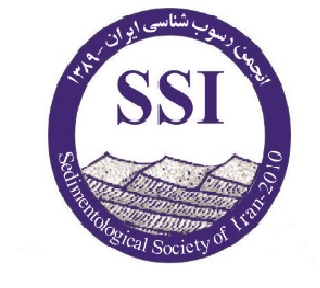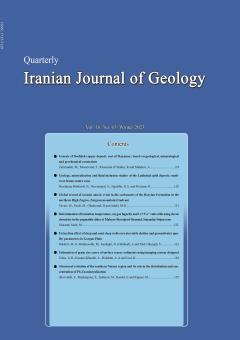Genesis of Dochileh copper deposit, east of Mayamey; based on geological, mineralogical and geochemical constraints
Subject Areas :Mahboobeh Zafarzadeh 1 , F. Mousivand 2 * , Ramzan Ramzani Umali 3 , Amir Mahdavi 4
1 - Shahrood University of Technology
2 -
3 -
4 - Birjand University
Keywords: Uplift# Michigan-type# Dochileh# Orogeny# Mayamey#,
Abstract :
Dochileh copper deposit is located 72 km east of Shahrood, 15 km east of Mayamey, in North Central Iran volcanic belt. The stratigraphic sequence of the region comprises a considerable amount of volcanic and volcanic-sedimentary deposits of Eocene. these deposits are locally covered by Neogen and Quaternary deposits. The volcanic rocks hosting mineralization are composed of different rocks including basalt, andesite basalt and trachy andesitebasalt rocks that often contain plagioclase and clinopyroxene phenocrysts. The copper mineralization mostly occurred along the faults and fractures with the dominant trend of NW-SE in the basaltic rocks as vein-veinlets and open space fillings. Ore minerals including primary native copper and hematite, and secondary minerals such as malachite, goethite, hematite. gangue minerals such as calcite, zeolite and analcime. The wallrock alterations in the host rocks include chloritic, carbonatic, analcime-zeolite and iron oxide. The oxidation of mafic minerals such as pyroxene and magnetite were responsible for copper reduction and hematitic alteration. Geochemical investigation indicates that amounts of Cu and Ag are up to 5.11 wt% and 7.8 ppm, respectively. According to field studies, mineralogy and alteration, the Duchileh copper deposit appears to be formed during diagenesis and burial metamorphism, and dominantly during the orogeny and uplift processes, due to enterance of hot ore fluids along the fractures and faults perpendicular to the fold axis. The Duchileh deposit have a large resemblance to the basaltic copper or Michigan-type copper deposits in terms of tectonic setting, host rock, mineralogy, metal content, alteration and ore controls.
ابراهیمی، س. و پادیار، ف.، 1394. پترولوژي و جایگاه تکتونوماگمایی کانسار مس دو چیله، شمال شرق شاهرود. هفتمین همایش انجمن زمینشناسی اقتصادی ایران، دامغان. 12.
آقانباتی، س. ع.، 1383. زمینشناسی ایران. سازمان زمینشناسی و اکتشافات معدنی کشور، 708 .
امینی.م، قلمقاش، ج. و مهرپرتو، م.، 1371. نقشه زمین¬شناسی100000/1میامی، سازمان زمین¬شناسی و اکتشافات معدنی کشور به شماره 7162.
بهزادي، م.، 1373. بررسي زمینشناسی اقتصادي انديس مس قبله بولاغ واقع در منطقه طارم سفلي- استان زنجان. پایاننامه کارشناسي ارشد زمینشناسی اقتصادي، دانشکده علوم زمين، دانشگاه شهيدبهشتي، 200 .
حمامی پور بارنجی، ب.، تاجالدین، ح.، موحدنیا، م.، 1401. زمینشناسی، ساخت و بافت، میان بارهای سیال و الگوی تشکیل کانه زایی مس طبیعی تیپ میشیگان در کانسار سه بندون، شمال شرق ایران. فصلنامه زمینشناسی ایران، 16، 61، 15-32.
صالحی، ل.، رساء، ا.، علیرضایی، س.، کاظمی مهرنیا، ا.، 1394. کانسار مس معدن بزرگ با میزبان آتشفشانی، نمونه¬ای از کانسارهای مس نوع مانتو، خاور شاهرود. فصلنامه علوم¬ زمین، سازمان زمین¬¬شناسی و اکتشافات معدنی کشور، 98، 93 تا 104.
طاشی، م.، موسیوند، ف. و قاسمی، ح.، 1395. الگوی رخداد کانه-زایی مس طبیعی در سنگ¬های آتشفشانی میزبان کانسار سولفید توده¬ای آتشفشان¬زاد مس- نقره گرماب پایین، جنوب شرق شاهرود. فصلنامه زمینشناسی ایران، 40، 89-105.
طائفی، ن.، صادقیان، م. و موسیوند، ف.، 1392. کانیشناسی، ساخت و بافت و الگوی رخداد کانه زایی مس نرتلویی و استغانی در جنوب شرق شاهرود، سی و دومین گردهمایی علوم زمین، سازمان زمینشناسی و اکتشافات معدنی کشور، تهران،21.
طائفی، ن.، موسیوند، ف. و صادقیان، م.، 1393. کانیشناسی و ژئوشیمی و الگوی رخداد کانه زایی مس در منطقه گریگ و گورخان، جنوب شرق شاهرود. ششمین همایش زمینشناسی اقتصادی، دانشگاه زاهدان، 15.
ظفرزاده، م.، 1397. کانی¬¬شناسی، ژئوشیمی و الگوی پیدایش کانسار مس دوچیله، شرق میامی. پایاننامه کارشناسي ارشد زمینشناسی اقتصادي، دانشکده علوم زمين، دانشگاه صنعتی شاهرود، 210.
ظفرزاده، م.، موسیوند، ف. و رمضانی اومالی، ر.، 1396. الگوی رخداد کانهزایی مس توران، شرق میامی، بر مبنای پژوهشهای ساخت و بافت و کانیشناسی مواد معدنی. کنفرانس ملی مهندسی مواد، متالورژی و معدن ایران، دانشگاه شهید چمران اهواز، 40.
مهابادی، م. و فردوست، ف.، 1398. بررسی رخداد کانه زایی در کانسار مس آبگاره، جنوب دامغان: براساس شواهد زمینشناسی، کانیشناسی و زمینشیمی. فصلنامه زمینشناسی ایران، 13، 51، 65-80.
محمدی، م.، نباتیان، ق.، هنرمند، م. و ابراهیمی، م.، 1398. زمینشناسی و خاستگاه کانه زايي مس در کانسار دهنه، شمال خاور زنجان. مجله زمینشناسی اقتصادی، 3 (22)، 11، 497-524.
Azizi, H. and Jahangiri, A., 2008. Cretaceous subduction-related volcanism in the northern Sanandaj-Sirjan Zone, Iran. Journal of Geodynamics, 45, 178–190.
Barnes, H.L., 1979. Geochemistry of hydrothermal ore deposits. Second ed. Wiley, NewYork, 797.
Berberian, F. and Berberian, M., 1981. Tectono-plutonic episodes in Iran. In: Zagros–Hindu Kush–Himalaya Geodynamic Evolution (H.K. Gupta and F.M. Delany, Eds), 5–32. American Geophysical Union and Geological Society of America, Washington.
Bing-Quana, Z.,Yao-Guo, H., Zheng-Weia, Z., Xue-Jun, C., Tong-Mo, D., Guang-Hao, C., Jian-Hua, P., Yong-Ge, S., De-Han, L., and Xiang-Yang, C., 2007. Geochemistry and geochronology of native copper mineralization related to the Emeishan flood basalts, Yunnan Province, China. Ore Geology Reviews, 32(1):366-380.
Bornhorst, T. and Lankton, D., 2009. Copper Mining: A Billion Years of Geologic and Human History. Published report.
Bornhorst, T.J. and Mathur, R., 2017. Copper Isotope Constraints on the Genesis of the Keweenaw Peninsula Native Copper District, Michigan, USA. Minerals, 7, 185.
Bornhorst, T.J., Paces, J.B., Grant, N.K., Obradovich, J.D., and Huber, N.K., 1988. Age of native copper mineralization, Keweenaw Peninsula, Michigan. Economic Geology, 83, 619–625.
Brown, A.C., 2006. Genesis of native copper lodes in the Keweenaw district, northern Michigan: A hybrid evolved meteoric and metamorphogenic model. Economic Geology, 101, 1437–1444.
Cabral, A.R., and Beaudoin, G., 2007. Volcanic red-bed copper mineralisation related to submarine basalt alteration, Mont Alexandre, Quebec Appalachians, Canada. Mineralium Deposita, 42, 901-912.
Carrillo-Rosúa, J., Boyce, A.D., Morales-Ruano, S., Morata, D., Roberts, S., Munizaga, F., and Moreno-Rodríguez, V., 2014. Extremely negative and inhomogeneous sulfur isotope signatures in Cretaceous Chilean manto-type Cu–(Ag) deposits, Coastal Range of central Chile. Ore Geology Reviews, 56, 13–24.
Cornwall, H.R., 1936. A summary of ideas on the origin of native copper deposits. Economic Geology, 51 (7) 615–631.
Dresser, J.A., 1936. Annual report of the Quebec Bureau of Mines. Part D: Mount Alexander map area.
Ghasemi, H., and Rezaei-Kahkhaei, M., 2015. Petrochemistry and tectonic setting of the Davarzan-Abbasabad Eocene volcanic (DAEV) rocks, NE Iran". Mineralogy and Petrology 109, 235–252.
Kirkham, R., 1996. Volcanic redbed copper. Geology of Canadian mineral deposit types. Geological Survey of Canada, Geology of Canada, 8, 241-252.
Mohajjel, M., and Fergusson, C.L., 2000. Dextral transpression in Late-Cretaceous continental collision, Sanandaj–Sirjan zone, Western Iran. Journal of Structural Geology, 22, 1125–1139.
Nezafati, N., Momenzadeh, M. and Pernicka, E., 2006. Darhand copper occurrence: an example of Michigan-type native copper deposits in central Iran, Mineral Deposit Research: Meeting the Global Challenge, 165-167.
Sengor, A.M.C., 1984. The Cimmerideorogenic system and the Tectonics of Eurasia. Geological society of America, Special, 195.
Shelly, D., 1993. Igneous and metamorphic rocks under microscope classification features, microstructures and mineral preferred orientations. Chapman and Hall, London, 405.
Sillitoe, R.H., 2010. Porphyry copper systems. Economic Geology, 105, 3-41.
Takin, M., 1972. Iranian geology and continental drift in the Middle East. Nature, 235, 147-150.
Wang, Q., Wyman, D.A., Xu, J.F., Wan, Y.S., Li, C.F., Zi, F., Jian, Z.Q., Qiu, H.N., Chu, Z.Y., Zhao, Z.H. and Dong, Y.H., 2008. Triassic Nb-enriched basalts, magnesian andesites, and adakites of the Qiangtang terrane (Central Tibet): evidence for metasomatism by slab-derived melts in the mantle wedge". Contributions to Mineralogy and Petrology 155, 473–490.
Woodruff, L.G., Schulz K.J., Nicholson S.W. and Dicken, C.L., 2020. Mineral deposits of the Mesoproterozoic Midcontinent Rift system in the Lake Superior region – A space and time classification. Ore Geology Reviews, 126, 103716.

